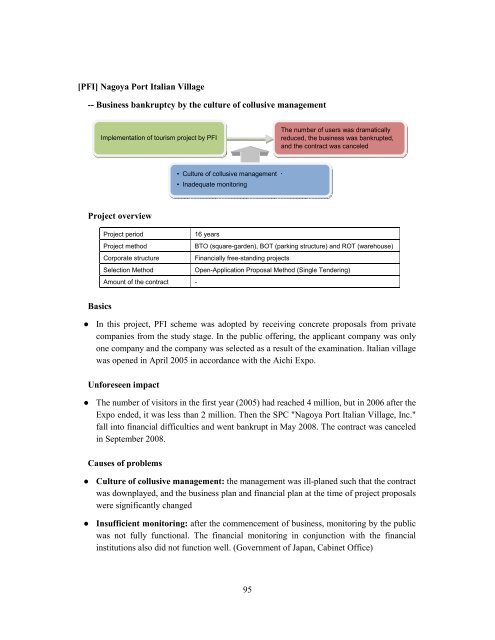Risk Management and Governance for PFI Project ... - Title Page - MIT
Risk Management and Governance for PFI Project ... - Title Page - MIT
Risk Management and Governance for PFI Project ... - Title Page - MIT
You also want an ePaper? Increase the reach of your titles
YUMPU automatically turns print PDFs into web optimized ePapers that Google loves.
[<strong>PFI</strong>] �agoya Port Italian Village<br />
-- Business bankruptcy by the culture of collusive management<br />
<strong>Project</strong> overview<br />
Basics<br />
Implementation of tourism project by <strong>PFI</strong><br />
<strong>Project</strong> period 16 years<br />
<strong>Project</strong> method BTO (square-garden), BOT (parking structure) <strong>and</strong> ROT (warehouse)<br />
Corporate structure Financially free-st<strong>and</strong>ing projects<br />
Selection Method Open-Application Proposal Method (Single Tendering)<br />
Amount of the contract -<br />
● In this project, <strong>PFI</strong> scheme was adopted by receiving concrete proposals from private<br />
companies from the study stage. In the public offering, the applicant company was only<br />
one company <strong>and</strong> the company was selected as a result of the examination. Italian village<br />
was opened in April 2005 in accordance with the Aichi Expo.<br />
Un<strong>for</strong>eseen impact<br />
● The number of visitors in the first year (2005) had reached 4 million, but in 2006 after the<br />
Expo ended, it was less than 2 million. Then the SPC "Nagoya Port Italian Village, Inc."<br />
fall into financial difficulties <strong>and</strong> went bankrupt in May 2008. The contract was canceled<br />
in September 2008.<br />
Causes of problems<br />
• Culture of collusive management •<br />
• Inadequate monitoring<br />
● Culture of collusive management: the management was ill-planed such that the contract<br />
was downplayed, <strong>and</strong> the business plan <strong>and</strong> financial plan at the time of project proposals<br />
were significantly changed<br />
● Insufficient monitoring: after the commencement of business, monitoring by the public<br />
was not fully functional. The financial monitoring in conjunction with the financial<br />
institutions also did not function well. (Government of Japan, Cabinet Office)<br />
95<br />
The number of users was dramatically<br />
reduced, the business was bankrupted,<br />
<strong>and</strong> the contract was canceled

















